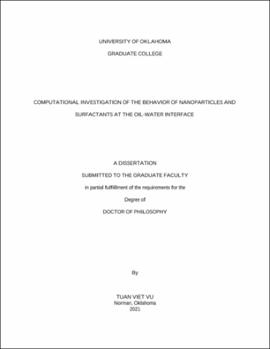| dc.description.abstract | Surfactants and nanoparticles (NPs) are commonly used to stabilize emulsions, which have found applications in different areas. The fundamental understanding of the behavior of surfactants and NPs adsorbed at the oil-water interface at different conditions is necessary for their applications. In this thesis, dissipative particle dynamics (DPD) simulation method was used to investigate computationally the individual and synergistic effects of surfactants and NPs at the oil-water interface. First, a systematic protocol to parameterize DPD models containing anionic surfactant (sodium dodecyl sulfate - SDS) or nonionic surfactant (octaethylene glycol monododecyl ether – C12E8) at the oil-water interface was constructed. It is important to place the theoretically calculated number of surfactant molecules at the interface at the critical micelle concentration. Based on this approach, the molecular description of surfactants and the effects of various interactions parameters on the interfacial tension were investigated. When adsorbing surfactants on the shape-anisotropic NPs such as carbon nanotubes (CNT), it was found that the adsorption capacities of SDS and C12E8 were 2.62 and 2.43 molecules/nm2, respectively. When the surfactant-adsorbed-CNTs reached the oil-water interface, the surfactant molecules quickly desorbed from the CNTs and distributed at the interface, leading to the reduction of the oil-water interfacial tension (IFT). At low surfactant concentration, the CNT remained at the interface, resulting in a further reduction of the IFT. When the surfactant interfacial concentration was high enough (at the value corresponding to the bulk critical micelle concentration (CMC)), the CNT was pushed into the oil phase, which did not have effects on the IFT. The synergistic effect of surfactants and various types of NPs on the oil-water interfacial tension was also investigated. It was found that at constant surfactant concentration, adding NPs reduced the IFT; while with the absence of surfactant, NPs expressed no effect on the IFT. Among different types of NPs, the most effective ones were those that maximized their footprint at the interface; thus, reducing the interfacial area available to surfactants. The interactions of the NPs with the surfactant molecules determined exactly which pattern of heterogeneity was most favorable. Based on these results, we formulated suggestions for designing NPs for maximum synergistic effects with surfactants. The stability of oil-in-water emulsion with the presence of SDS surfactants and Janus nanoparticles was also studied. Two oil droplets with different Janus particle surface coverages and surfactant surface concentrations were pushed towards each other for coalescing. The coalescence progressed by moving the Janus particles away from the point of drop contact, followed by the diffusion of surfactant from the contact area to allow the direct oil-oil contact. The emulsion stability was quantified using the difference of free energy between the final and the initial state of coalescence. At particle coverage of less than 70% of the drop surface, Janus particles alone could not thermodynamically stabilize the emulsion. However, when combined with surfactants, Janus particles would improve emulsion stability by increasing the effective surfactant concentration on the emulsion surface. Finally, the behavior of C12E8 surfactant and Janus nanoparticles at the oil-water interface under compression was investigated. Compression of the interface with only surfactants resulted in the expulsion of surfactant molecules to the water phase once the interfacial concentration of surfactant molecules reached the CMC value. Compression of a Janus particle-laden interface past the closed-packing point led to a buckled interface so that the total interfacial area remained constant upon further compression. When both surfactants and JPs were present at the interface, JPs still caused buckling, which helped retain the surfactant molecules at the interface. The interface exhibited a higher level of deformation in presence of surfactants. When the surfactant concentration was high, under compression, the surfactants were partitioned into the water phase, but the buckling of the interface persisted. | en_US |
